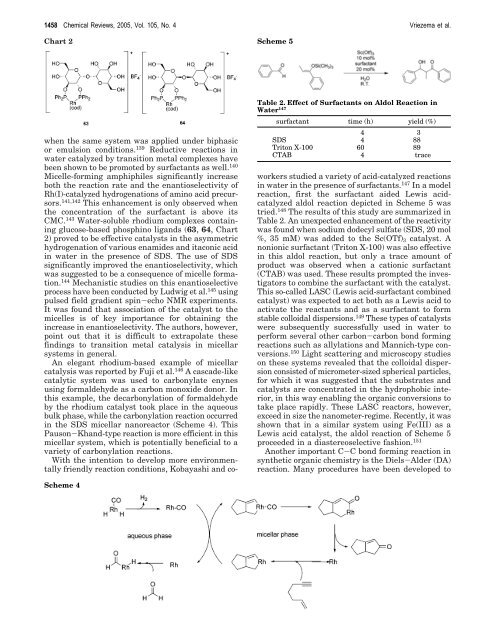Self-Assembled Nanoreactors - Cluster for Molecular Chemistry
Self-Assembled Nanoreactors - Cluster for Molecular Chemistry
Self-Assembled Nanoreactors - Cluster for Molecular Chemistry
You also want an ePaper? Increase the reach of your titles
YUMPU automatically turns print PDFs into web optimized ePapers that Google loves.
1458 Chemical Reviews, 2005, Vol. 105, No. 4 Vriezema et al.<br />
Chart 2<br />
when the same system was applied under biphasic<br />
or emulsion conditions. 139 Reductive reactions in<br />
water catalyzed by transition metal complexes have<br />
been shown to be promoted by surfactants as well. 140<br />
Micelle-<strong>for</strong>ming amphiphiles significantly increase<br />
both the reaction rate and the enantioselectivity of<br />
Rh(I)-catalyzed hydrogenations of amino acid precursors.<br />
141,142 This enhancement is only observed when<br />
the concentration of the surfactant is above its<br />
CMC. 143 Water-soluble rhodium complexes containing<br />
glucose-based phosphino ligands (63, 64, Chart<br />
2) proved to be effective catalysts in the asymmetric<br />
hydrogenation of various enamides and itaconic acid<br />
in water in the presence of SDS. The use of SDS<br />
significantly improved the enantioselectivity, which<br />
was suggested to be a consequence of micelle <strong>for</strong>mation.<br />
144 Mechanistic studies on this enantioselective<br />
process have been conducted by Ludwig et al. 145 using<br />
pulsed field gradient spin-echo NMR experiments.<br />
It was found that association of the catalyst to the<br />
micelles is of key importance <strong>for</strong> obtaining the<br />
increase in enantioselectivity. The authors, however,<br />
point out that it is difficult to extrapolate these<br />
findings to transition metal catalysis in micellar<br />
systems in general.<br />
An elegant rhodium-based example of micellar<br />
catalysis was reported by Fuji et al. 146 A cascade-like<br />
catalytic system was used to carbonylate enynes<br />
using <strong>for</strong>maldehyde as a carbon monoxide donor. In<br />
this example, the decarbonylation of <strong>for</strong>maldehyde<br />
by the rhodium catalyst took place in the aqueous<br />
bulk phase, while the carbonylation reaction occurred<br />
in the SDS micellar nanoreactor (Scheme 4). This<br />
Pauson-Khand-type reaction is more efficient in this<br />
micellar system, which is potentially beneficial to a<br />
variety of carbonylation reactions.<br />
With the intention to develop more environmentally<br />
friendly reaction conditions, Kobayashi and co-<br />
Scheme 4<br />
Scheme 5<br />
Table 2. Effect of Surfactants on Aldol Reaction in<br />
Water147 surfactant time (h) yield (%)<br />
4 3<br />
SDS 4 88<br />
Triton X-100 60 89<br />
CTAB 4 trace<br />
workers studied a variety of acid-catalyzed reactions<br />
in water in the presence of surfactants. 147 In a model<br />
reaction, first the surfactant aided Lewis acidcatalyzed<br />
aldol reaction depicted in Scheme 5 was<br />
tried. 148 The results of this study are summarized in<br />
Table 2. An unexpected enhancement of the reactivity<br />
was found when sodium dodecyl sulfate (SDS, 20 mol<br />
%, 35 mM) was added to the Sc(OTf)3 catalyst. A<br />
nonionic surfactant (Triton X-100) was also effective<br />
in this aldol reaction, but only a trace amount of<br />
product was observed when a cationic surfactant<br />
(CTAB) was used. These results prompted the investigators<br />
to combine the surfactant with the catalyst.<br />
This so-called LASC (Lewis acid-surfactant combined<br />
catalyst) was expected to act both as a Lewis acid to<br />
activate the reactants and as a surfactant to <strong>for</strong>m<br />
stable colloidal dispersions. 149 These types of catalysts<br />
were subsequently successfully used in water to<br />
per<strong>for</strong>m several other carbon-carbon bond <strong>for</strong>ming<br />
reactions such as allylations and Mannich-type conversions.<br />
150 Light scattering and microscopy studies<br />
on these systems revealed that the colloidal dispersion<br />
consisted of micrometer-sized spherical particles,<br />
<strong>for</strong> which it was suggested that the substrates and<br />
catalysts are concentrated in the hydrophobic interior,<br />
in this way enabling the organic conversions to<br />
take place rapidly. These LASC reactors, however,<br />
exceed in size the nanometer-regime. Recently, it was<br />
shown that in a similar system using Fe(III) as a<br />
Lewis acid catalyst, the aldol reaction of Scheme 5<br />
proceeded in a diastereoselective fashion. 151<br />
Another important C-C bond <strong>for</strong>ming reaction in<br />
synthetic organic chemistry is the Diels-Alder (DA)<br />
reaction. Many procedures have been developed to

















